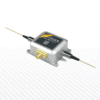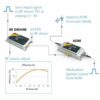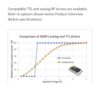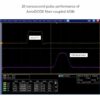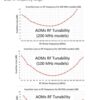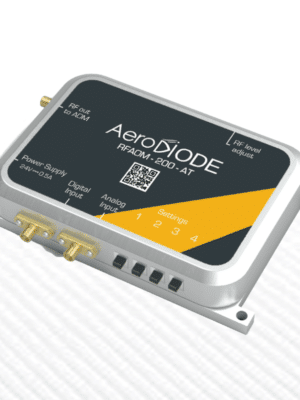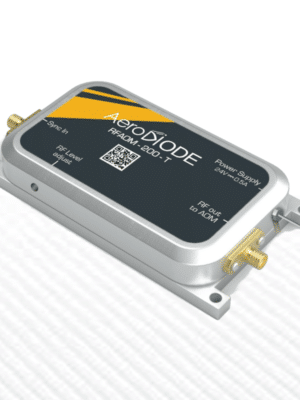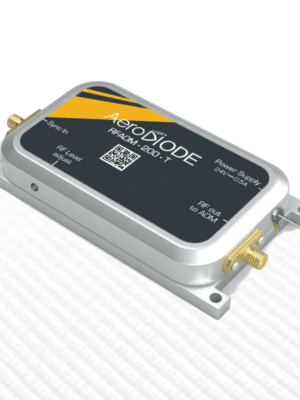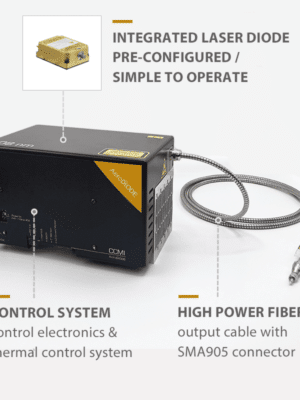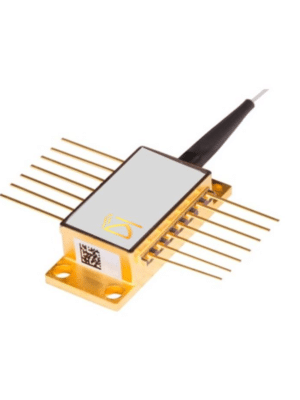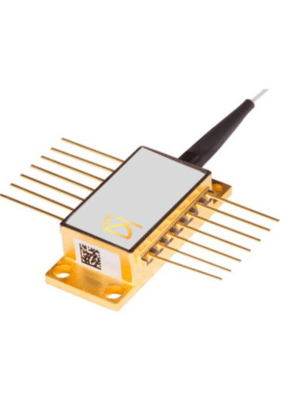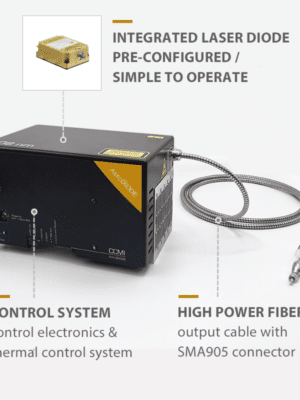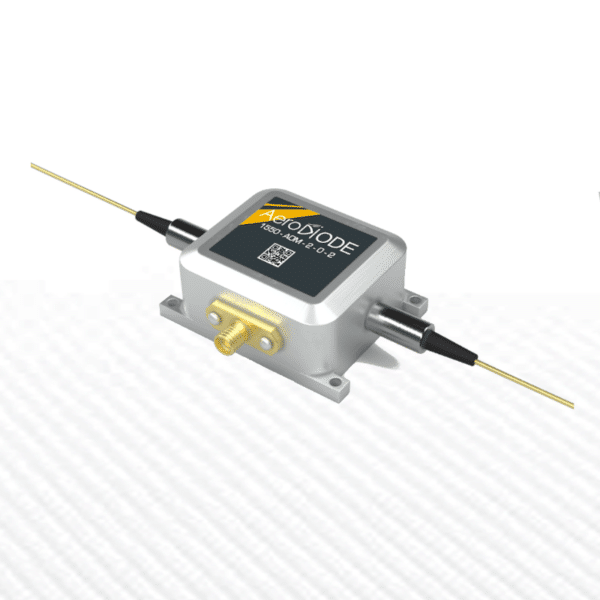
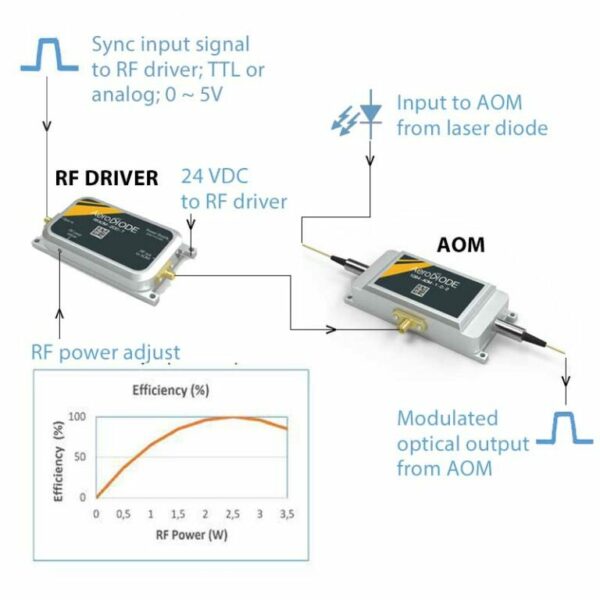
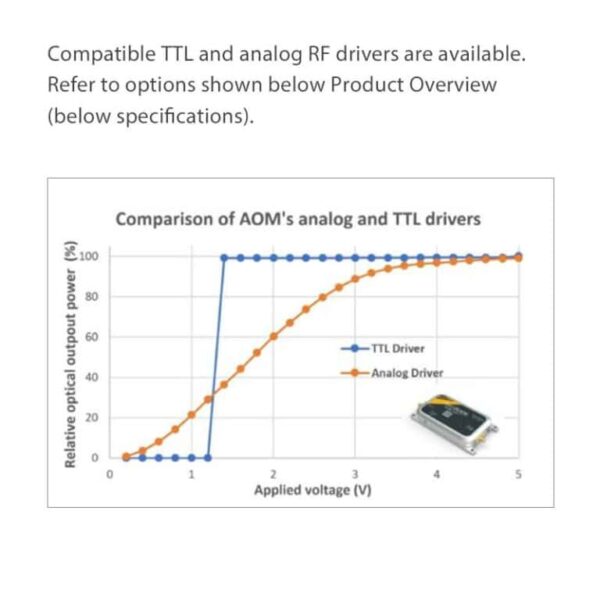
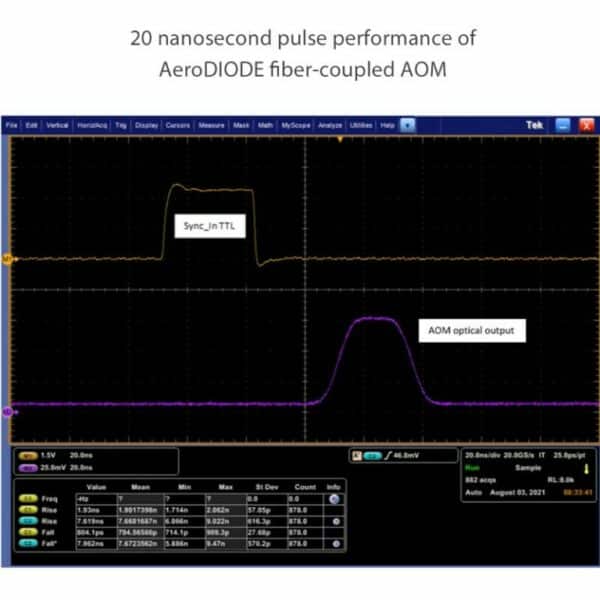
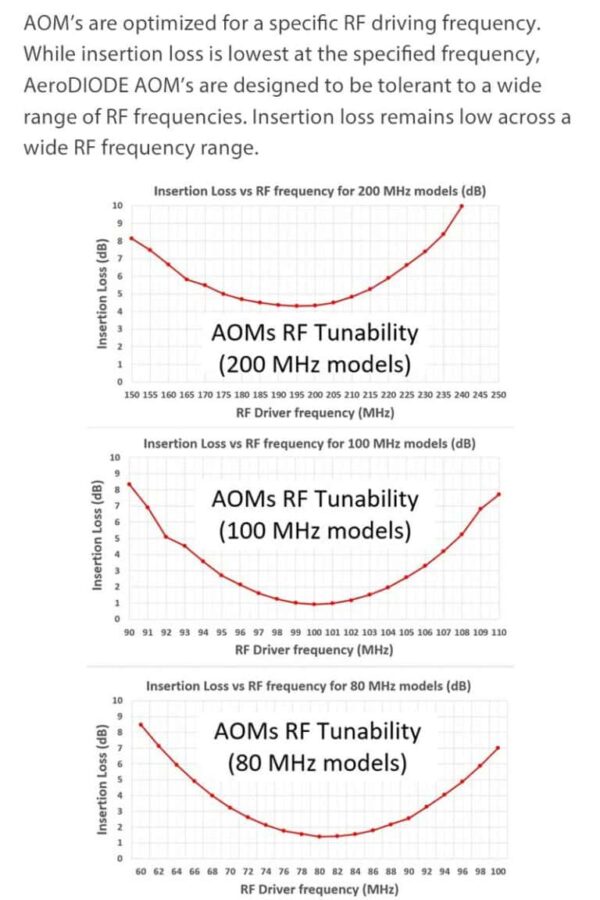
GENERAL SPECIFICATIONS
- Wavelength Range: 1580 nm - 1720 nm
- Max. Avg. Power: 0.5 Watt
- Max. Peak Power: 0.5 kW
- Insertion Loss: 4 dB – 5 dB (4.5 dB typical) **
- Extinction Ratio, First Order: 60 dB (typ)
- Rise Time: 9.5 ns (typ)
- Frequency: 200 MHz
- Frequency Shift: ±200 MHz
- RF Power: 3 W (max)
- Input Impedance: 50 Ω
- Electrical Interface: SMA
- Fiber Type: PM 1550
- Fiber Length: 1 m
- Fiber Termination: FC/APC
- Working Temperature: -20ºC to 60ºC
- Storage Temperature: -30ºC to 70ºC
- Dimension: 45 mm x 28 mm x 12 mm (not counting fiber boots)
- Mounting Holes Diameter: 3 mm
- ** Insertion loss over the nominal wavelength ±50 nm. Add 0.5 dB to cover the full wavelength range
1650nm Acousto Optic Modulator, 200 MHz, Fiber Coupled AOM
Key Features
- Efficient 200 MHz Fiber-Coupled Optical Modulator
- 1580 nm - 1720 nm Operating Wavelength Range
- High First-Order Extinction Ratio, > 55 dB
- TECH-NOTE: Acousto Optic Modulator Set-Up Guide Example
- Tech-Support & Sales in North America by LaserDiodeSource.com, part of Laser Lab Source
Shipping Information
Shipping within the USA: $155.00
International Shipments: Shipping Account Required
Offered by: Aerodiode Corporation, a Laser Lab Source Marketplace Seller
Orders fulfilled by: Laser Lab Source in North America
Sold & Supported in North America by Laser Lab Source
Orders for this product are processed and fulfilled by Laser Lab Source, the marketplace for Laser Scientists and Engineers. This item ships from Bozeman, MT USA. It is manufactured by Aerodiode, a Laser Lab Source Marketplace Seller. Mfg Part Number: 1650AOM-2
Warranty Information
This product is sold with a full one year warranty. It is warrantied to be free from defects in material and/or workmanship for a period of one year from the date of shipment. The warranty is transacted and honored by Laser Lab Source for product purchases made through Laser Lab Source.
|
Weight |
1 lbs |
|---|---|
|
Dimensions |
12 × 9 × 4 in |
|
AOM Frequency |
200 MHz |
|
AOM Wavelength |
1650 nm |
|
AOM Rise Time |
10 nanoseconds |
|
AeroDIODE AOM |
aerodiode aom modulators |
|
Aerodiode AOM's 1000 - 1600nm |
1650 nm |
Product Overview
1650nm Fiber acousto-optic modulator (AOM) Overview
These high-speed fiber-coupled acousto-optic modulators (AOM) are an ideal for fast amplitude modulation of laser light in a single mode optical fiber operating wavelength range of 1580nm to 1720nm. These AOMs are used in Q-switched fiber laser and pulse picking applications, narrow line width laser measurements, and many other applications related to precision fiber-coupled systems operating in the nanosecond range.
Low Insertion Loss, High Input Power
These AOMs are efficient and are designed to be easy to use. WIth low insertion loss, high input power capability, and high extinction ratio, they are ideal for a wide range of applications. The low-loss Bragg cell material is chosen for its ability to support the high-Q acoustic refractive index grating that is fundamental to the operation of the AOM.
Matched RF Driver for Acousto-Optic Modulator
The AOM operates at a set frequency of 200 MHz, determined by the physical configuration of the Bragg cell.
In order to drive the AOM, a high power RF signal is needed at the AOM operating frequency; the signal power is typically up to a few watts. An RF Driver/Amplifier is required to amplify the low-level output from a signal generator to the power level needed to drive the acousto-optic modulator. The RF generators offered here integrate seamlessly with the AOMs and provide a one-stop solution for high-speed Q-switched, fiber-coupled laser modulation.
Three different matched RF drivers are available for driving the 1650nm AOM, one designed for analog input signals and another RF driver for TTL input signals. A high speed driver is also available for combined TTL / Analog input signals. Links to these products are available below in the You May Also Like section.
To learn more about how acousto optic modulators function and learn how to set up an AOM, please visit our TECH-NOTE: “Acousto Optic Modulator Basics and Set-Up Guide”
